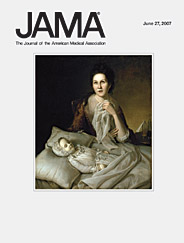


|
|
|
|
|
|
|
|
|
|
|
|
||||||||||||||
|
||||||||||||||
|
|
||||||||||||||
|
||||||||||||||
|
Posted
06/26/2007   White
youths have the highest rate of diabetes among all racial/ethnic
groups in the United States, and type 1 is the most common form of
diabetes among youth, according to a study in the June 27 issue of
the Journal of the American Medical Association. White
youths have the highest rate of diabetes among all racial/ethnic
groups in the United States, and type 1 is the most common form of
diabetes among youth, according to a study in the June 27 issue of
the Journal of the American Medical Association.
The study reports that the annual number of newly
diagnosed U.S. youths with type 1 diabetes is approximately 15,000.
“Type 1 and type 2 diabetes are more common than
expected,” said Dr. Elizabeth Mayer-Davis, a diabetes researcher in
the Arnold School of Public Health at the University of South
Carolina and one of the paper’s authors.
“For youth under age 10, who’ve been diagnosed with
diabetes, almost all have type 1 diabetes,” she said. “Among
African-American youths over age 10, about 60 percent have type 2,
and about 40 percent have type 1. Type 2 diabetes occurs in about 20
percent of white children diagnosed with diabetes over age 10.”
To put those statistics in perspective for the
Palmetto State, about 265 youths are diagnosed with diabetes each
year.
“Childhood diabetes is much less common than
childhood asthma and slightly more common than childhood cancer,”
Mayer-Davis said.
The study is part of the SEARCH for
Diabetes in Youth Study Group, a national research program begun in
2000 to determine the prevalence and incidence of diabetes among
U.S. youth. The university is one of six clinical sites for the
program. Funding is from the Division of Diabetes Translation at the
Centers for Disease Control and Prevention (CDC) and the National
Institute of Diabetes and Digestive and Kidney Diseases, a part of
the National Institutes of Health (NIH).
 Mayer-Davis
chairs the national study and is the principal investigator for the
SEARCH site in South Carolina. Dr. Angela Liese, a researcher in the
Arnold School of Public Health, also is an investigator for the
SEARCH program. Mayer-Davis
chairs the national study and is the principal investigator for the
SEARCH site in South Carolina. Dr. Angela Liese, a researcher in the
Arnold School of Public Health, also is an investigator for the
SEARCH program.
Dr. Dana Dabelea, a SEARCH investigator
at the University of Colorado at Denver and the lead author on the
JAMA report, said the number of youths with newly diagnosed diabetes
varies across major U.S. racial and ethnic groups and across age
groups.
The researchers identified 2,435 youths who were diagnosed
with type 1 and type 2 diabetes in 2002 and 2003. The estimated
overall incidence of diabetes in youths is 24.3 per 100,000
annually.
Among the study’s other findings:
•
Among ages 10-14, type 1 diabetes was most frequent among
non-Hispanic white youths (32 cases per 100,000 annually). For
African-American and Hispanic adolescents, the incidence was the
same: 19.2 cases per 100,000. Type 1 was much less common among
Asian-Pacific Islander (8.3 cases per 100, 000) and American-Indian
youths (7.1 cases per 100,000).
• Newly diagnosed type 2 diabetes was extremely rare in
children under age 10 and gradually increased with age. Among
minority adolescents and young adults 15-19 years old, the highest
incidence was among American Indians (49.4 cases per 100,000),
Asian-Pacific Islanders (22.7 cases per 100,000), African Americans
(19.4 cases per 100,000) and Hispanics (17 per 100,000).
• Although still relatively infrequent, type 2 diabetes was
found among non-Hispanic whites ages 15 - 19 (5.6 cases per
100,000).
• The incidence of type 1 diabetes from this study is higher
than the incidence of insulin-dependent diabetes mellitus reported
by previous U.S. childhood diabetes registries.
The report in JAMA also states that the
incidence of type 1 diabetes appears to have increased worldwide
during the past two decades. Although type 2 diabetes traditionally
has been viewed as a disorder in adults, it is increasing in youths,
especially racial/ethnic minority populations.
Type 1 diabetes is an autoimmune
disease in which a person’s own immune cells attack and destroy the
beta cells of the pancreas, which produce the hormone insulin needed
for survival. Many researchers believe that the disease arises from
a combination of susceptibility genes and environmental triggers,
such as an infection or dietary component, that have not yet been
identified, Mayer-Davis said.
Having diabetes affects a child and
family’s lifestyle. The long-term health effects, including
blindness, nerve damage and cardiovascular and kidney diseases, can
be serious if diabetes is not managed through diet, physical
activity and medication, she said.
“Like any chronic disease, diabetes
requires understanding the disease and its treatment and maintaining
a healthy lifestyle, including physical activity and a diet, to
maintain an appropriate weight for the individual,” Mayer-Davis
said. “Compliance with medications, as prescribed, is vital to an
individual’s health.”
The report in JAMA also states that the
incidence of type 1 diabetes appears to be increasing worldwide
during the past two decades. Although type 2 diabetes traditionally
has been viewed as a disorder in adults, it is increasing in youths,
especially racial/ethnic minority populations.
|
| Columbia, SC 29208 • 803-777-7000 • sphweb@gwm.sc.edu | © University of South Carolina Board of Trustees |